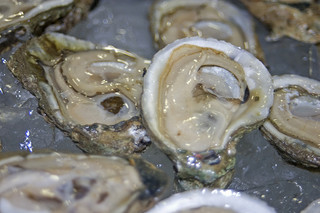
Apalachicola Oysters: Importance and Decline
Worldwide, oysters and their habitats have declined in population. National concern over the reduced oyster populations and potential failure of the Oyster fishery in Apalachicola Bay have been recently featured in the news.
In September, Jack Payne, University of Florida IFAS Senior Vice President for Agriculture and Natural Resources announced the formation of the UF Oyster Recovery Task Force. This group, now called the UF Oyster Recovery Team, includes members from various stakeholders including scientists, industry, public health representatives and more. Florida Sea Grant is leading the team and director Karl Havens is the Chair.
“The recovery team has multiple priorities, including learning why oyster populations declined, finding ways to help them bounce back, and identifying solutions for social and economic impacts”, Havens said. A firm date has not been set for the recovery team’s final report, but the team is hoping to deliver some results to the community by early 2013.
Eastern oysters are more than just a tasty treat! They provide a variety of functions to the bays and estuaries. They are a staple to the health and wellness of our bay. These organisms are hearty and tolerant of a wide range of salinity conditions from fresh to full-strength seawater. However, they are most “happy” when they are living in brackish water (a mixture of fresh and salt water).
Oysters are considered an important keystone species because of the variety of functions they provide for the areas they inhabit. Considered biofilters, oysters have the ability to filter up to 24 gallons of water per day. They help to control algal blooms, lower the amount of suspended sediment, silt and nutrients, and improve water quality/clarity. Oysters also provide critical food and habitat by creating solid three dimensional structures, referred to as reefs in the areas they grow. This reef structure provides habitat to many other fish and invertebrate species that live in the estuary.
Historically, the oysters harvested from Apalachicola Bay represent approximately 10 percent of the U.S. oyster harvest and about 90 percent of Florida’s harvest. This oyster fishery is an icon of our state and many jobs are dependent on this industry. The future is uncertain. However, the members of the Oyster Recovery Team are hopeful that by working together, the oyster resources will rebound and that a sustainable oyster management plan will be in place to insure the future of this vital fishery.
Follow news for the UF Oyster Recovery Team’s efforts at the UF-IFAS Franklin County Website or http://franklin.ifas.ufl.edu
To help with support of seafood workers and disaster relief efforts in Franklin County visit the BAYAID website or Franklinspromisecoalition.org
UF/IFAS scientists and UF Oyster Recovery Team Members, Bill Pine and Peter Frederick, have been studying oyster communities along the Big Bend of Florida and hope that by studying these un-impacted oyster beds, they can help restoration efforts in Gulf and around the world be more efficient and effective.